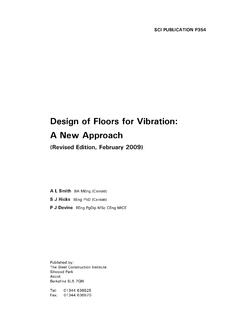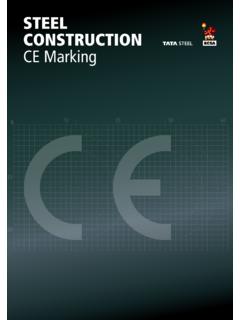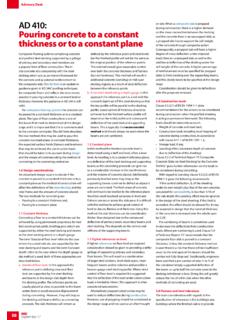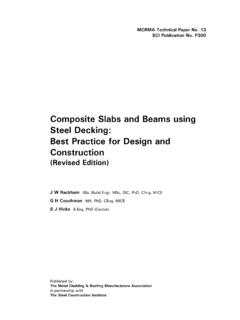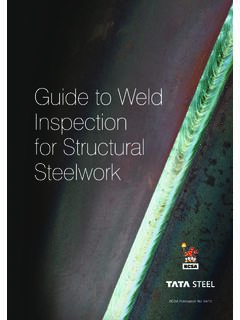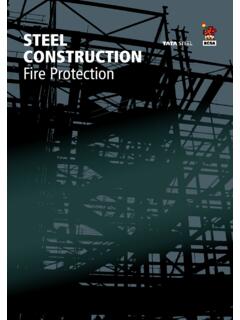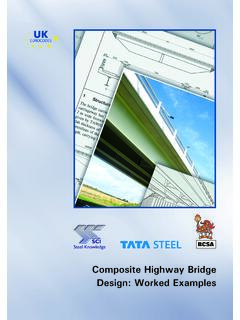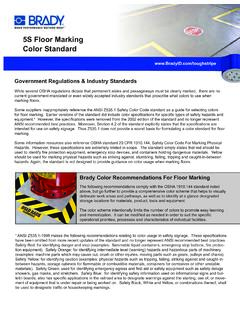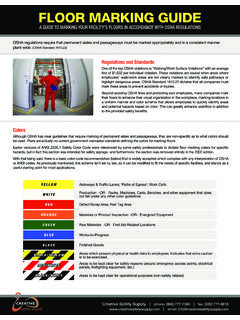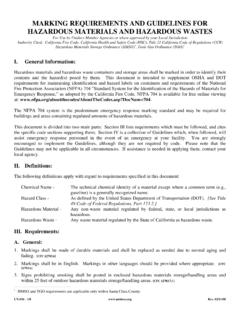Transcription of STEEL CONSTRUCTION Floor Vibration
1 STEELCONSTRUCTIONF loor Vibration2 Floor VIBRATIONS teel for Life and the British Constructional Steelwork Association (BCSA) are working closely together to promote the effective use of structural steelwork. This collaborative effort ensures that advances in the knowledge of the use of constructional STEEL are shared with industry is, by some margin, the most popular framing material for multi-storey buildings in the UK and has a long track record of delivering high quality and cost-effective structures with proven sustainability benefits. STEEL can be recycled and re-used continuously, and offers a wide range of additional advantages such as health and safety benefits, speed of CONSTRUCTION , quality, efficiency, innovation, offsite manufacture and service and support. The STEEL sector is renowned for keeping specifiers abreast of the latest advances in areas such as fire protection of structural steelwork and achieving buildings with the highest sustainability ratings.
2 Recent publications have provided detailed guidance on Fire Protection and CE Marking and what it means for the CONSTRUCTION sector. Guidance is provided on all relevant technical developments as quickly as is sector s go to resource website is a free online encyclopedia for UK CONSTRUCTION that shares a wealth of up-to-date, reliable information with the CONSTRUCTION industry in one easily accessible place. Follow us on: Twitter @steelcoinfo LinkedIn: Facebook: Google+: publication has been funded by STEEL for Life and would not be possible without the support of our sponsors:Gold sponsors: AJN Steelstock Ltd | Ficep UK Ltd | Kingspan Limited | National Tube Stockholders and Cleveland STEEL & Tubes | Parkersteel | voestalpine Metsec plc | Wedge Group Galvanizing LtdSilver sponsors: Hadley Group, Building Products Division | Jack Tighe LtdBronze sponsors: BAPP Group of Companies | Barnshaw Section Benders Limited | Hempel | Joseph Ash Galvanizing | Kaltenbach Limited | SherwinWilliams | Tension Control Bolts Ltd | Voortman STEEL MachineryBARRETTSTEEL LIMITEDFLOOR Vibration 3 Introduction 4 What are Floor vibrations and why are they important?
3 5 Basic Theory 6 Continuous systems 6 Human induced Vibration 6 Damping 7 Resonant response 7 What levels of Floor Vibration are acceptable? 9 How can Floor vibrations be assessed? 12 Manual methods 12 Simplified web-based tool 12 Finite element analysis 13 Mitigation 13 Case studies 14 1: SCI office building 14 2: Composite Floor with dissimilar spans 16 Summary 18 Project features12 Hammersmith Grove 3 Aberdeen Community Health & Care Village 4 Technology and Innovation Centre, University of Strathclyde 8 Isaac Newton Academy 11 Walbrook Building 15 Manchester Cancer Research Centre 17 Creechurch Place, London 18 ContentsThe 10-storey 12 Hammersmith Grove will offer speculative Grade A office space, ground Floor and mezzanine level retail space and a generous double-height entrance by architect Flanagan Lawrence, 12 Hammersmith Grove is a STEEL -framed composite designed structure, utilising long-span cellular beams throughout for economy and to allow the integration of services within the structural centrally placed cores provide the STEEL frame with its stability.
4 While the majority of the structural grid follows a m 10 m pattern throughout the building. This grid also incorporates some longer spans of up to 15 m on all incorporate the 15 m long spans, make sure the beams were stiff enough to negate any footfall Vibration , and have big enough holes to accept all of the services and thereby keep Floor -to-ceiling heights the same, the cellular beams are all 650 mm deep sections. They incorporate 450 mm diameter service holes and support a metal deck with a 150 mm thick Hammersmith Grove4 Floor VIBRATIONI ntroductionSteel structures can meet even the strictest Vibration performance criteriaIn recent years, there has been an increase in demand for buildings that are fast to construct, have large uninterrupted Floor areas and are flexible in their intended final use. Modern design and CONSTRUCTION techniques enable STEEL CONSTRUCTION to satisfy these demands and deliver structures which are competitive in terms of overall cost.
5 For most multi-storey commercial buildings, straightforward STEEL CONSTRUCTION will meet the required Vibration performance criteria without modification. For more Vibration -sensitive applications, such as hospital operating theatre floors or research laboratories, STEEL s advantages can be utilised, although stiffer solutions may be necessary. Even if a stiffer Floor is required, STEEL remains the most cost-effective and lightweight solution. Long-span applications, for which STEEL is the only option, have been found to offer good dynamic performance, despite common preconceptions that STEEL composite floors are thought to be livelier than concrete ones. This is because the stiffer beams and large mass of the long-span Floor plates, which participates in any motion, reduce the magnitude of the Vibration response. The STEEL sector has extensive experience in designing STEEL structures to ensure compliance with even the strictest Vibration performance guide is an introduction to the subject of Floor vibrations.
6 It describes what they are, what levels are acceptable and how they are assessed, and introduces a new web-based simple design of interest: Floor Vibration 5 The term vibrations when applied to floors refers to the oscillatory motion experienced by the building and its occupants during the course of normal day-to-day activities. This motion is normally vertical (up and down), but horizontal vibrations are also possible. In either case, the consequences of vibrations range from being a nuisance to the building users to causing damage to the fixtures and fittings or even (in very extreme cases) to the building structure. The severity of the consequences will depend on the source of the motion, its duration and the design and layout of the vibrations are generally caused by dynamic loads applied either directly to the Floor by people or machinery. The most common source of Vibration that can cause nuisance in building applications is human activity, usually walking.
7 Although small in magnitude, walking-induced vibrations can cause a nuisance to people working or living in the building, especially to the use of sensitive equipment or to those engaged in motion-sensitive activities, surgery. Naturally, the problem is more acute for more vigorous types of human activity such as dancing and jumping and therefore designers of buildings featuring a gymnasium or dance studio should take extra care to limit the vibrations in the rest of the vibrations are best dealt with at source through the provision of isolating mounts or motion arresting pads. Machines installed in factories tend to produce the most severe vibrations due to their size and the nature of their operation. However, Floor Vibration is rarely a problem in most factories, since it is accepted by the workforce as part of the industrial environment. Once constructed, it is very difficult to modify an existing Floor to reduce its susceptibility to Vibration , as only major changes to the mass, stiffness or damping of the Floor system will produce any perceptible reduction in Vibration amplitudes.
8 It is important therefore that the levels of acceptable Vibration be established at the concept design stage, paying particular attention to the anticipated usage of the floors. The client must be involved in this decision, as the specified acceptance criteria may have a significant impact on the design of the Floor and the cost of are Floor vibrations and why are they important?Criteria such as the size, shape, multiple uses and a constrained site all lead to a STEEL -framed solution for the Community Health and Care Village in as a hospital without beds, the centre includes departments for minor surgery, dentistry, radiology, sexual health services, physiotherapy, dietetics, speech and language therapy, as well as careers advice and information. With such a variety of uses to be accommodated within a single highly flexible, three level 17,251 m2 structure, steelwork was always going to be the framing material of of the nature of the intended usages within the structure, such as clinical operations, Vibration was an important design consideration and the stringent Vibration standard required for hospitals had to be met.
9 Compliance of the STEEL Floor plate was demonstrated using the methodology to calculate Vibration response given in SCI s guide Community Health & Care Village6 Floor VIBRATIONC ontinuous systems A beam has a mass, stiffness and boundary conditions at the supports that define its behaviour. The system has a fundamental frequency which corresponds to the first (lowest) mode of Vibration . In this mode, the Vibration reaches maximum amplitude in one position (an antinode), at mid-span of the beam. In the second mode, two antinodes are present at quarter points and so on. This system is described as continuous because there are theoretically an infinite number of modes of Vibration . The Vibration is the result of an input force which can either be continuous as produced by walking, or discrete such as a single heel-drop on a Floor fundamental frequency of a simply supported beam may be estimated from the mid-span deflection using the following expression.
10 The formula also gives a reasonable estimate for fixed-ended beams and cantilevers if the appropriate deflection is calculated. 1 = ( in millimetres). Floors also behave as continuous structural systems. In STEEL buildings they often consist of primary and secondary beams arranged in a regular orthogonal grillage with a composite Floor slab. The whole Floor is a continuous horizontal structural system supported at the columns. Because of the continuity, excitation in one part of a Floor can be felt some distance away, if the frequency of the forcing function, the response of the Floor and the degree of damping are unfavourable. An example would be where vibrations are felt some distance away from a person walking along a natural frequency of the whole Floor system may be estimated using the equation given previously where is the sum of the component deflections for slab, secondary and primary beams.
